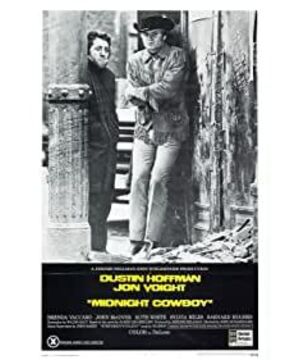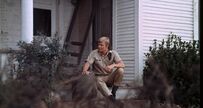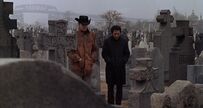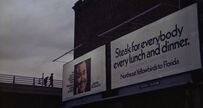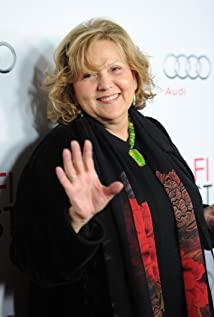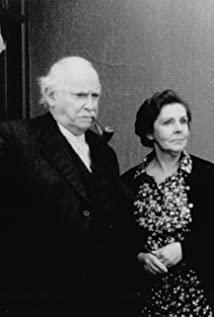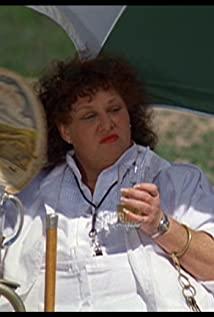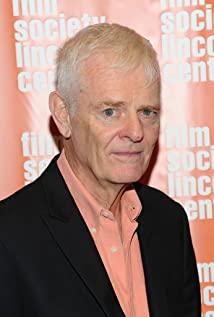The film world is colorful and voluminous, and has produced countless beautiful scenes for more than a hundred years, which are unforgettable and breathtaking. But in my movie viewing experience, there is no movie that moved me as much as the American movie "Midnight Cowboy", which kept flashing in front of my eyes a western cowboy with a simple and kind temperament and a handsome and handsome appearance. The scene of walking on the road with a poor man with a crouched body and a crippled foot, accompanied by the melodious but sad harmonica theme music, presents us the lonely and helpless scene of people living at the bottom of the metropolis. So sad, so touching!
John Schlesinger - The London-born theatre director directed this milestone in film history with his keen observation of American society in the late 1960s, accurate analysis, and genius directing techniques. The film, based on the novel of James Leo Herlisi, is known as the representative work of "New Hollywood Film" and won the 42nd Oscar in 1969 for Best Picture, Best Director and Best Adapted Screenplay III. It became the only R-rated film to ever win the Oscar for Best Picture, and led Hollywood on the path of neorealism throughout the 1970s. The film focuses on depicting a pure and kind-hearted German cowboy Joe Buck with the dream of starting a career in the east, hoping to become a male prostitute with his handsome appearance and healthy and strong physical condition to please rich women, but when When he was in the metropolis of New York, he realized how far away reality was from his dreams. Not only did he not earn a substantial income, but because of his inexperience, he was ripped off $20 after serving a woman; serving a gay man After the boy provided the service, he didn't get a penny until he met the destitute Risso, who was tricked by the self-proclaimed "economic man" into a $20 referral fee and was kicked out of the hotel because he couldn't pay the room fee and lived on the street. , trying to get revenge when he ran into Risso again, but because Risso and his sympathy became friends with each other, they had to move to Risona's dilapidated apartment that was about to be demolished. In order to help Rizzo's wish to go to Florida, Buck had to sell his only belongings - a radio and even blood for a living. On the long-distance bus bound for Miami, the seriously ill Rizzo died in Buck's arms. At this time, there were coconut trees outside the window...
A classic film that is enough to be recorded in film history usually has the following elements: an excellent storyline, delicate character characterization, skilled directing techniques and excellent actor performances, but in this work that expresses human nature and social reality, it has exactly the following elements. And highlight these elements and characteristics, so that the whole film is filled with sincere and touching affection and subtle performance of the social status quo. The general form of the film adopts the interspersed narrative technique of time and space. Dreams and real scenes, memories and reality form a shadow, but it is not monotonous, boring or even incomprehensible. On the contrary, it is elastic and harmonious, with a degree of relaxation. The metaphorical pictures of all are greatly improved the appreciability and expressiveness of the film. They are deep but not boring, jumpy but not messy, delicate but not tedious, showing the director's profound artistic skills in controlling the storyline and good at expressing the inner world of the characters.
Joe Buck is so happy and confident when he steps on the bus to New York, full of infinite vision for a better future, when reality and memory are intertwined, the mutual love and indulgence between him and his ex-girlfriend, and his childhood being raped by his grandmother. The scene of the treatment brings out Buck's innocence and kindness and his once wounded and lonely heart. After experiencing repeated defeats, Buck fell into a situation of disappointment and helplessness. At this time, the bustling city around him was no longer so charming and gorgeous, and the chaotic street scene was accompanied by the panicked running and loneliness of the people living here at the bottom. , where is their safe place? Where is the beginning of realizing their ideals? Buck, who was wandering in the busy city, became less calm and confident, with helplessness, panic and disappointment in his eyes. Getting to know Risso seems like a good turning point, but the wretched lame man in front of him deceives the kind and innocent Buck with his "experienced" expression and sympathetic eyes, until they become friends, one of two men in similar circumstances. The friendship between them gradually spread. They lived together in a cold and broken room, stole food and clothing together, danced together to keep warm, went to pawnshops together to make a living, went to big restaurants to try to do business together, and went to hippie fashion together. Gathering together, and embarking on a journey to a foreign country in pursuit of a new life... The director uses rich and multi-layered pictures to continuously construct the miserable and desolate scenes of the small and medium-sized people in the prosperous big city, and this scene of poor people is staged in the corner of the city. Tragedy of fate.
The United States in the mid-to-late 1960s was a place where openness and conservatism coexisted with opportunities and challenges. Hippie, homosexuality, sexual liberation, male prostitutes, pagan beliefs and other phenomena appeared to be different in a society where the gap between the rich and the poor was intensified. In addition, when the U.S. government was in the quagmire of the Vietnam War, and anti-war demonstrations continued one after another, the values and moral values of the American people were undergoing unprecedented impact and influence. "Midnight Cowboy" is straightforward and clear about these common phenomena. With deep depiction and characterization, a large number of psychological expressions of characters and real scenes complement each other, making the camera a pair of eyes that care about itself and examine the society, record and present that special page of history and those people who are struggling to survive, thus endowing the film with a heavyweight. Meaning and profound meaning.
The highlight of the film is the level and tension of the two actors, Jon Voight as Buck and Dustin Hoffman as Rizzo. Someone once jokingly described the profession of "actor" as "round eyes". Although it is a joke, as an excellent performer, the appeal of the eyes plays an unusual key role. Look at Buck's joyful and simple eyes when he first set out on a long journey, look at his disappointed and helpless eyes when he was beaten by repeated failures, and look at his lost eyes when he faced the boy's pitiful pleading; Look at his relaxed eyes, look at his sad eyes when he went to the cemetery to mourn his father, look at his longing eyes when he stood outside the hotel and fantasize about running on Miami Beach, look at his sad and sad eyes when he was seriously ill. Eyes, we finally understand what is excellent performance art, what is excellent performance level. At that time, Jon Voight and Dustin Hoffman were just showing their heads and feet. The former starred in the 1967 Western film "Duel of the Dragon and Tiger Mountain" and the latter won the 1967 Oscar for "The Graduate". The male lead nominations showed extraordinary acting talent, and their wonderful performance in "Midnight Cowboy" obviously surpassed their young self at the time. The outstanding performance of the two actors earned them both nominations for the 42nd Academy Award for Best Actor for this film. Although the final winner was John Wayne ("Thunderbolt"), it is a pity that they are in The artistic achievements in this film are still widely recognized and praised by critics and audiences, and have been shining brightly as a classic example of film performance teaching materials many times.
It is also worth mentioning John Barry's film soundtrack. The music and the picture complement each other, and the cheerful and light western country-style theme song "Everybody Speaks to Me" contrasts the sad and desolate tone and charm of the film, leading the theme music infection. The soul of each audience makes the atmosphere, style and meaning of the film perfectly sublimated.
"I'm walking here!" This is what Rizzo and Buck say when a taxi nearly hits Rizzo as he and Buck walk through the busy streets. Forty years later, Jon Voight and Dustin Hoffman are still walking here, walking in the world of light and shadow; "Midnight Cowboy" director John Schlesinger July 2003 Because he died of a stroke in the United States, this masterpiece will follow his eternal back, continue to walk here, and walk in the colorful film river!
- This article was first published on April 13, 2009 by Yan Nanfei
View more about Midnight Cowboy reviews


